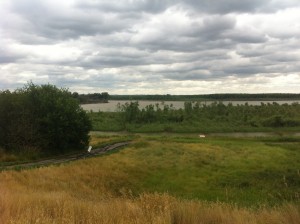
Undaunted Courage by Stephen E. Ambrose (1996. Simon and Schuster. ISBN9780684826974)
On a recent trip to visit my son Dylan and his wife-to-be Shelly out on the prairie (Williston, ND), my wife and my son Jack and I toured Fort Union, a reconstructed fur trading post located on the Missouri River straddling the North Dakota/Montana border. I bought Undaunted Courage in the fur post’s gift shop on the recommendation of one of the park rangers. I was intent on learning more about a topic that I didn’t know much about beyond elementary school history: Lewis and Clark’s Expedition to explore the Louisiana Purchase. After finishing the book between customers this past weekend at the Northwoods Art and Book Festival, I am glad the young ranger made the recommendation.
First, the author. Stephen Ambrose passed away in 2002 but he left us a rich legacy of history and biography. The man who pieced together the combat exploits and personal lives of the soldiers of Easy Company into a moving portrayal of ordinary men doing extraordinary things (Band of Brothers) didn’t craft a linear history of the Corps of Discovery, as Merriweather Lewis labeled the famed expedition from St. Louis to the Pacific in 1803. Rather, the author created a travel biography featuring Lewis and including a cast of equal (Clark and Thomas Jefferson) and lesser characters (Sacagawea). There’s ample background material here regarding Lewis’s early life (especially well researched is the period Lewis spent working as Jefferson’s personal assistant) but the heart and soul of the narrative is the arduous and sometimes precarious journey by boat, foot, and horseback across the Great Plains, the Rockies, and the open spaces of Washington and Oregon. Ambrose does an excellent job of explaining the reasons behind the trek and the intricacies of the politics, both national and international, that led President Jefferson to first buy the parcel known as Louisiana from Napoleon, and then send a small rag tag band of soldiers, citizens, and Native guides to explore the vastness of that newly acquired territory. The author writes in clear and concise terms, draws from historical dialogue and narrative when needed, and paints a vivid retrospection of what the men on this ordeal went through. His detailed examination of the friendship between Lewis and Jefferson and Lewis and Clark are worth the read alone.
But this isn’t a great book, merely and impressive and noteworthy book. Why? At times I found myself distracted by Ambrose’s scholarly attention to detail. There were moments while reading reading when the author diverted my attention from the human drama of the expedition down a path built upon Lewis’s fastidious naturalism. Sometimes these detailed excursions into the flora and fauna left me a bit befuddled from, and tired of, facts and scholarship. The ending of the story, which I didn’t recall (I must have been napping during that hour of history in 5th grade) is sad, tragic, and mysterious in the context of the larger narrative. Though the story, as I’ve critiqued, tends to meander a bit in the middle, the beginning and ending make this an excellent place for a reader to begin his or her own voyage of discovery into this well-known, but oft misunderstood, part of the American historical tapestry.
If you find yourself in the vicinity of Williston, I’d highly recommend a side trip to the interpretative center at the confluence of the Yellowstone and the Missouri Rivers as well as Fort Union to put this fine historical story in perspective.

Confluence of the Yellowstone and Missouri.
4 stars out of 5.
Mark


